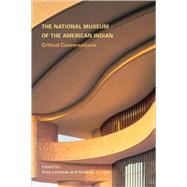
Note: Supplemental materials are not guaranteed with Rental or Used book purchases.
Purchase Benefits
Looking to rent a book? Rent The National Museum of the American Indian: Critical Conversations [ISBN: 9780803211117] for the semester, quarter, and short term or search our site for other textbooks by Lonetree, Amy; Cobb, Amanda J.. Renting a textbook can save you up to 90% from the cost of buying.
| List of Illustrations | p. x |
| Acknowledgments | p. xi |
| Introduction | p. xiii |
| History and Development | |
| A New Thing?: The National Museum of the American Indian in Historical and Institutional Context | p. 3 |
| Decolonizing the "Nation's Attic": The National Museum of the American Indian and the Politics of Knowledge-Making in a National Space | p. 43 |
| Concourse and Periphery: Planning the National Museum of the American Indian | p. 84 |
| Indigenous Methodology and Community Collaboration | |
| Critical Reflections on the Our Peoples Exhibit: A Curator's Perspective | p. 131 |
| Collaborative Exhibit Development at the Smithsonian's National Museum of the American Indian | p. 144 |
| The Making of Who We Are: Now Showing at the National Museum of the American Indian Lelawi Theater | p. 165 |
| Interpretations and Response | |
| Gym Shoes, Maps, and Passports, Oh My!: Creating Community or Creating Chaos at the National Museum of the American Indian? | p. 181 |
| "Indian Country" on the National Mall: The Mainstream Press versus the National Museum of the American Indian | p. 208 |
| What Are Our Expectations Telling Us?: Encounters with the National Museum of the American Indian | p. 241 |
| No Sense of the Struggle: Creating a Context for Survivance at the National Museum of the American Indian | p. 267 |
| (Un)disturbing Exhibitions: Indigenous Historical Memory at the National Museum of the American Indian | p. 290 |
| "Acknowledging the Truth of History": Missed Opportunities at the National Museum of the American Indian | p. 305 |
| Questions of Nation and Identity | |
| The National Museum of the American Indian as Cultural Sovereignty | p. 331 |
| Performing Reconciliation at the National Museum of the American Indian: Postcolonial Rapprochement and the Politics of Historical Closure | p. 353 |
| "South of the Border" at the National Museum of the American Indian | p. 384 |
| Inside Out and Outside In: Re-presenting Native North America at the Canadian Museum of Civilization and the National Museum of the American Indian | p. 405 |
| The National Museum of the American Indian and the Siting of Identity | p. 431 |
| The Contributors | p. 449 |
| Index | p. 455 |
| Table of Contents provided by Ingram. All Rights Reserved. |
The New copy of this book will include any supplemental materials advertised. Please check the title of the book to determine if it should include any access cards, study guides, lab manuals, CDs, etc.
The Used, Rental and eBook copies of this book are not guaranteed to include any supplemental materials. Typically, only the book itself is included. This is true even if the title states it includes any access cards, study guides, lab manuals, CDs, etc.